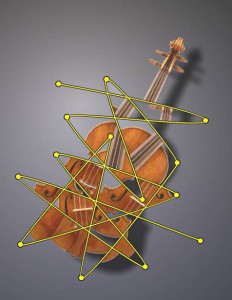
This page contains demonstrations of some of the phenomena described in our 2006 Nature Neuroscience article investigating the role of ongoing eye movements in influencing perceptual coherence. Our main finding is that ongoing smooth pursuit eye movements help disambiguate scenes that are inherently ambiguous during fixation. This is the case even when the retinal stimulation experienced by subjects is matched as much as possible across eye movement conditions.
Basic Effect
In the following movie, maintaining fixation on the small central spot makes it extremely difficult to perceptually integrate the four moving line segments into a coherent occluded chevron (shown in full for a portion of the movie).
However, when the spot is tracked, such that the retinal input is identical to that in the movie above, the chevron is readily perceived. Note that the chevron is now stationary in the world, but it is moving on the retina just as in fixation.
Effects with Moving Objects
Improvements in perceptual coherence during tracking can also occur with moving objects. The following movie shows an occluded diamond during fixation. Note that it is difficult to judge the true direction of motion of the diamond when it is partially occluded, consistent with an incoherent percept. With the central spot fixated, the occluded diamond appears to move along a more vertical axis than its true 45 degree axis (evident when the diamond is shown in full for a portion of the movie).
The same retinal motion of the diamond above can be achieved during horizontal tracking if the diamond moves vertically. In this condition, when the small spot is tracked, the diamond is perceived more coherently, and, as a result, its direction of motion in space is determined more veridically by subjects.
